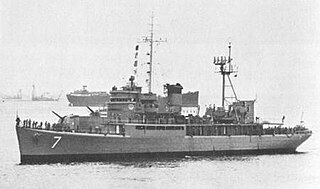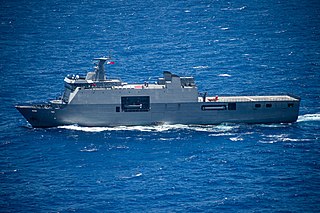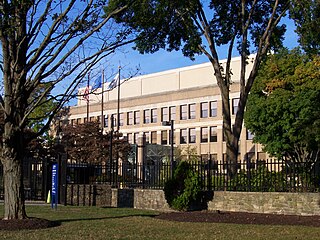
The United States Coast Guard cutter Morgenthau, was the eighth of twelve 378-foot dual-powered turbine/diesel Hamilton-class high endurance cutters (WHECs) built by Avondale Shipyards in New Orleans, Louisiana. The Coast Guard commissioned the Morgenthau on March 10, 1969. After 48 years of continuous distinguished service the U.S. Coast Guard decommissioned the Morgenthau on April 18, 2017, and the ship was sold to Vietnam. On 27 May 2017 the Vietnam Coast Guard commissioned the former cutter as patrol craft CSB-8020.

The Hamilton-class cutter was the largest class of vessel in the United States Coast Guard until replaced by the Legend-class cutter, aside from the Polar-class icebreakers. The hull classification symbol is prefixed WHEC. The cutters are called the Hamilton class after their lead ship, or "Secretary class" because most of the vessels in the class were named for former Secretaries of the Treasury.

USCGC Hamilton (WHEC-715) was a US Coast Guard high endurance cutter and the lead ship of its class. Hamilton was based in Boston MA from commissioning until 1991 and then out of San Pedro, CA before it was moved to its last home Port in San Diego, California. Launched December 18, 1965 at Avondale Shipyards near New Orleans, Louisiana and named for Alexander Hamilton, the first United States Secretary of the Treasury and founder of the United States Revenue Cutter Service. She was commissioned March 18, 1967.

USCGC Boutwell (WHEC-719) was a United States Coast Guard high endurance cutter based out of San Diego, California. Named for George S. Boutwell, United States Secretary of the Treasury under President Ulysses S. Grant. Boutwell engaged in many CG missions, including Search and Rescue, Law Enforcement, Maritime Security, and National Defense.

USS Bering Strait (AVP-34) was a United States Navy Barnegat-class small seaplane tender in commission from 1944 to 1946. She tended seaplanes during World War II in the Pacific in combat areas and earned three battle stars by war's end.

The BRP Rajah Humabon (PS-11) is a former destroyer escort of the United States Navy and a former frigate of the Philippine Navy. It was the last World War II-era destroyer escort/frigate active in its fleet, and one of the oldest active warships in the world, until 15 March 2018 when it was formally decommissioned after 75 years. She was one of three ex-USN Cannon-class destroyer escorts that served the Philippine Navy, the others being BRP Datu Sikatuna (PF-5/PS-77) and BRP Datu Kalantiaw (PS-76).

BRP Andrés Bonifacio (PF-7) was a Philippine Navy frigate in commission from 1976 to 1985. She was one of six ex-United States Navy Barnegat-class small seaplane tenders/ex-United States Coast Guard Casco-class high endurance cutters received from the United States after the Vietnam War, two of which were acquired to supply spare parts for the other four. Andrés Bonifacio was considered the lead ship of her class in the Philippine Navy, and she and her three commissioned sister ships were the largest Philippine Navy combat ships of their time.

USS Chincoteague (AVP-24) was a United States Navy seaplane tender in commission from 1943 to 1946 that saw service in the Pacific during World War II. After the war, she was in commission in the United States Coast Guard as the cutter USCGC Chincoteague (WAVP-375), later WHEC-375, from 1949 to 1972. She was transferred to South Vietnam in 1972 and was commissioned into service with the Republic of Vietnam Navy as the frigate RVNS Lý Thường Kiệt (HQ-16), seeing combat in the Battle of the Paracel Islands in 1974. When South Vietnam collapsed at the conclusion of the Vietnam War in 1975, she fled to the Philippines, where she was commissioned into the Philippine Navy, serving as the frigate RPSAndrés Bonifacio (PF-7) from 1976 to 1985.

The Andrés Bonifacio class is a ship class of four frigates that served with the Philippine Navy from 1976 to the mid-1990s. These ships were formerly used by the US Navy as Barnegat-class small seaplane tenders and by the US Coast Guard as Casco-class Coast Guard High Endurance Cutters. Under the Philippine Navy, the four vessels have undergone upgrades and modification, and were categorized as frigates. During their time, they were considered as the largest Philippine Navy combat ships of her time.
BRP Diego Silang (PF-9) was an Andrés Bonifacio-class frigate of the Philippine Navy in commission from 1976 to 1990. She and her three sister ships were the largest Philippine Navy ships of their time.
The BRP Francisco Dagohoy (PF-10) was an Andrés Bonifacio-class frigate of the Philippine Navy that served from 1979 to 1985. She was one of six ex-United States Navy Barnegat-class small seaplane tenders and ex-United States Coast Guard Casco-class high endurance cutters received from the United States after the Vietnam War, two of which were cannibalized for spare parts without entering service. She and her other three sister ships were the largest Philippine Navy ships of their time.
The BRP Gregorio del Pilar (PF-8) was an Andrés Bonifacio-class frigate of the Philippine Navy in commission from 1977 to 1990. She was one of six ex-United States Navy Barnegat-class seaplane tenders/ex-United States Coast Guard Casco-class high endurance cutters received from the United States after the Vietnam War, two of which were acquired to supply spare parts for the other four. She and her three commissioned sister ships were the largest Philippine Navy combat ships of their time.

USS Castle Rock (AVP-35) was a United States Navy Barnegat-class small seaplane tender in commission from 1944 to 1946 which saw service in the late months of World War II. After the war, she was in commission in the United States Coast Guard as the Coast Guard cutter USCGC Castle Rock (WAVP-383), later WHEC-383, from 1948 to 1971, seeing service in the Vietnam War during her Coast Guard career. Transferred to South Vietnam in 1971, she served in the Republic of Vietnam Navy as the frigate RVNS Trần Bình Trọng (HQ-05) and fought in the Battle of the Paracel Islands in 1974. When South Vietnam collapsed at the end of the Vietnam War in 1975, Trần Bình Trọng fled to the Philippines, where she served in the Philippine Navy from 1979 to 1985 as the frigate RPSFrancisco Dagohoy (PF-10).

USS Wachapreague (AGP-8) was a motor torpedo boat tender in commission in the United States Navy from 1944 to 1946, seeing service in the latter part of World War II. After her Navy decommissioning, she was in commission in the United States Coast Guard from 1946 to 1972 as the cutter USCGC McCulloch (WAVP-386), later WHEC-386, the fourth ship of the U.S. Coast Guard or its predecessor, the United States Revenue Cutter Service, to bear the name. In 1972 she was transferred to South Vietnam and served in the Republic of Vietnam Navy as the frigate RVNS Ngô Quyền (HQ-17). Upon the collapse of South Vietnam at the end of the Vietnam War in 1975, she fled to the Philippines, and she served in the Philippine Navy from 1977 to 1985 as the frigate RPSGregorio del Pilar (PF-8) and from 1987 to 1990 as BRP Gregorio del Pilar (PF-12).

The Barnegat class was a large class of United States Navy small seaplane tenders (AVP) built during World War II. Thirty were completed as seaplane tenders, four as motor torpedo boat tenders, and one as a catapult training ship.

BRP Gregorio del Pilar (FF-15) is a frigate of the Philippine Navy and the lead ship of her class. She was the second ship of the Philippine Navy to be named after Gregorio del Pilar, a Filipino revolutionary general known for his role at the Battle of Tirad Pass. She was originally designated as "PF-15" from 2011 to mid-2016 when the PN adopted a new code designation system, re-designating her to "FF-15".

BRP Ramon Alcaraz (FF-16) is a frigate in the Philippine Navy and the second ship of the Gregorio del Pilar class. From 1968 to 2012, she was known as USCGC Dallas and served the United States Coast Guard as a high endurance cutter. She was decommissioned on 30 March 2012 and acquired by the Philippines under the Excess Defense Articles and the Foreign Assistance Act.

BRP Davao del Sur (LD-602) is the second and last ship of her class of the Philippine Navy's landing platform docks. She is the second ship to be named after the Philippine province of Davao del Sur, one of the main provinces in Mindanao in Southern Philippines.




























